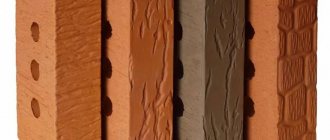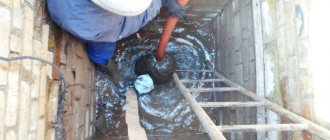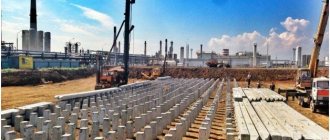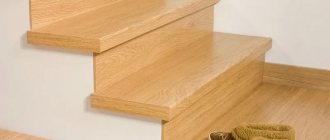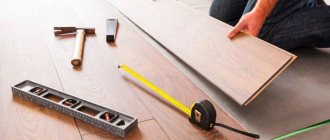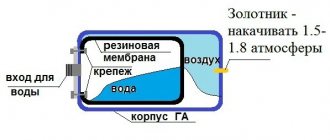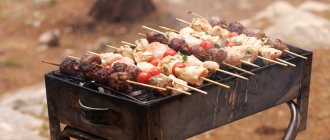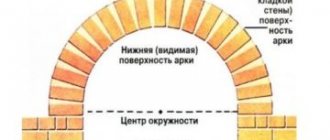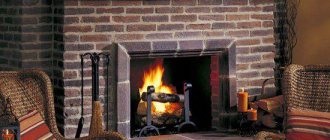Stoves are quite common today, even though there are more modern heating systems. For a bath or sauna, to provide additional heating in the house, brick stoves remain indispensable. Such a stove can be built from red or fireclay bricks, but fireclay brick itself is too expensive and is rarely used for stove bodies . Most often, the masonry is made from red stove bricks, and fireclay is used for the firebox. The result is excellent quality at optimal financial costs.
Fireclay brick is frost-resistant and can withstand temperatures up to 1500 degrees.
The laying of the stove itself is carried out in compliance with the order, i.e., a special layout for each row. The diagram shows how much material is used and in what order the individual bricks and other elements of the future furnace will be arranged. To begin masonry work, you must first decide what the stove structure will be. Today 3 types are used:
- A heating and cooking stove is the best option, which is suitable for ensuring a comfortable temperature in the house and for cooking. Special compartments for baking bread are popular, but bricks should be chosen carefully; fireclay cannot be used, since when heated it releases chemicals, and this is unacceptable when cooking.
- Conventional cooking stoves are intended only for cooking, boiling cabbage soup, and drying fruit.
- Heating stoves and fireplaces are designed to heat a certain area or room.
There are separate heaters for baths; the process of laying them differs from conventional stoves. It is necessary to install a special grate for stones and a container for heating water. The stove itself must be durable and resistant to temperature changes.
Heat-resistant brick for the stove: which one is better to choose
The choice of brick for constructing a stove should be special, since not only the integrity of the future structure, but also the safety of the home depends on it. In the modern world, electric or gas stoves, central heating, and radiators are used to heat the house. But there are people who prefer a stove with real, live fire to all these devices. Moreover, many lay out the stoves with their own hands. In this case, it is necessary to choose the right material so that the fireplace works for a long time and with high quality.
What is the best way to finish?
If the stove has an independent meaning as part of the interior design, then it is best to use plastic-molded facing bricks to decorate it. It is almost always 2nd grade; this is exactly what is needed for the stove shell. When building a new furnace, the facing bricks are simply laid on the outside. Then the finishing happens by itself, and 3 birds with one stone are killed at once: the stove breathes deeply, takes on the appearance, as long as the seams are neatly cut, and comes out durable, because All seams are tied properly.
If you are covering an old stove, then you don’t have to think about bandaging the seams of the masonry with the lining, if only because the old ones have dried out. But the “thermal kicks” will eventually do their job and the lining will begin to peel off. Previously, in such cases, the stove was first lined with unglazed tiles on lime mortar, and on top of it - with bricks on the same mortar. The tiles played the role of a kind of damper. Now you can do it easier and cheaper: mix the masonry mortar of the cladding using the same aluminous cements.
Decorating the fireplace to fit into the interior
It also happens that, according to the designer’s plan, a stove or fireplace should fit organically into the interior, at least as shown in Fig. Then 3 options are possible: narrow decorative brick, pos. 1 on the right in the figure, hand-molded Ekaterinoslav brick, pos. 2, and clinker facing tiles, item 3. The latter is a little expensive, but the best in quality: clinker tiles are well matched according to the TKR with brick, are durable, adhere tenaciously to any mortar, are available in a variety of colors and textures and allow the stove to breathe - there are few pores in clinker Yes, there is, but the thickness of the tiles is small.
Narrow brick is suitable for fireplaces: a stove lined with it will not be able to breathe. You need to purchase it carefully: manufacturers often use polymer additives. According to the certificate, the heat resistance of narrow bricks for lining fireplaces must be at least 140 degrees.
As for the heavily advertised Ekaterinoslav (or eagle) brick, there are no complaints about its quality. But the price is clearly too high compared to the capabilities of the material. Apparently, the marketing service is guided by the principle: Mercedes stands for the star, and we stand for the double-headed eagle. Maybe they charge a fee for fear: Ekaterinoslav is the present-day Dnepropetrovsk, the appanage patrimony of the notorious lord (or rebbe?) Kolomoisky.
Although who knows how P/R Kolomoisky looks at this eagle. You can’t deny him (p/r Kolomoisky, not the eagle) resourcefulness. So, it was decided one day. national revolutionaries under Kolomoisky emerge as a dangerous competitor. They say that by law it is impossible to be a governor with dual citizenship. So he was immediately found: “And I have not a double, but a triple!” Here, please, is a Ukrainian passport, here is an Israeli one, and here is a Cypriot one! Where in the n-π law is multiple citizenship prohibited? So, please, at least load two-passport passports into a cannon, uncut, and at the separatist terrorists. Don't touch me! I have three passports, I can! Otherwise, the battalion boys will immediately explain how the laws should be interpreted!”
Scratched pp. national revolutionaries where they wear a hat: but it’s true, there is nothing in the law about n-π multiple citizenship. It wasn’t written down, they didn’t think of it, nor did they think about the only possible thing that would be most correct and simplest. They retreated, and so the p/r Kolomoisky remained to rule his patrimony.
Types of bricks
Manufacturers produce different types of bars, which are made from clay, water, additives and other additives, and then dried and fired, giving them strength.
But there are several types of rectangles that do not require clay to produce. This is hyper-pressed and silicate brick. Materials used in construction have different purposes. Some bars are used for laying walls and partitions and are called masonry bars, while others are used to decorate the outer walls of a house. These products are called facing.
Ceramic rectangles and building bricks that do not contain clay can have a smooth, rough, or corrugated surface. Thanks to special additives, they can be given not only different colors, but also unusual patterns and designs. Common types of bars used in the construction and decoration of walls are:
- silicate;
- fireclay;
- hyper-pressed;
- ceramic;
- clinker;
- facing.
Each of them has its own set of characteristics, and also has advantages and disadvantages.
Sand-lime brick
This brick is considered the most affordable in price, because it does not require firing. The main component for its production is quartz sand (93%), the remaining 7% is lime. The material acquires density as a result of a chemical reaction in which lime is slaked. If nothing else is added to the mass, the product is white. Sand-lime brick is made in an autoclave, where the material is steamed at high temperature (200°C).
White bars are intended for both cladding and wall laying. But if you are going to use them to build housing, it is worth considering that they have high thermal conductivity. Since the product is resistant to temperatures above 200°C, stoves are not used from this brick. Silicate rectangles are not recommended for use in the construction of a basement floor, as they interact with groundwater and sulfur salts dissolved in them, which can lead to deterioration of the material.
White bars are well suited for building interior walls of a home. If you don’t know which brick is best to buy for cladding a house, take a closer look at the silicate product. It has high strength and density. To give the walls of your house an unusual look, you should choose a facing rectangle not with a smooth surface, but with an uneven or torn surface. This rusticated material, similar to wild stone, does not require additional plastering of the wall. They can decorate door and window openings.
Ceramic Hollow Red Brick
Hollow brick made of baked clay is cheaper than solid brick, because its production requires less material. Each block has holes and cavities. In construction, the advantage of such products is a lower load on the foundation of the house, low thermal conductivity and sound insulation, therefore they are often used as masonry elements of building walls.
If sawdust is added to hollow ceramic bricks during production, then when they burn during firing, they will leave behind small voids - pores. One bar of such porous material costs more than a hollow product, but is larger in size. Thus, a cubic meter of it can be purchased for the same price as a cubic meter of hollow rectangles. Porous bricks have better thermal conductivity than bricks with cavities. And thanks to their large sizes, they are convenient to lay out and can be quickly erected at home, saving on mortar.
Hyperpressed brick
This material is used in construction in the construction of foundations and basements, walls and fences. But more often it can be seen on the cladding of facades, columns, window and door openings. It is the most durable type of brick, because it is resistant to high and low temperatures and precipitation. No cracks form on it, and it will serve not only its owners, but also their distant descendants. You can build a house from hyper-pressed timber at any time of the year. The smooth surface of the product ensures high adhesion strength to the mortar and speeds up the masonry process.
Hyperpressed bricks consist of 86-92% crushed stone, limestone, marble, dolomite, facing stone waste or blast furnace slag. These durable products contain the best cement and coloring pigments. The formation of rectangles occurs under high pressure. As a result of hyper-pressing, all elements of the block are closely interlocked with each other, so the artificial brick acquires the moisture resistance, strength and frost resistance of the natural material (stone). This block has only two drawbacks: a large load on the support (foundation) and a high price.
Clinker brick
When producing clinker bars, refractory clay is fired at temperatures above 1000°C. As a result of this process, the brick is sintered and there are no voids left in it. The resulting monolith is highly durable and does not allow water to pass through. Due to its frost resistance, it can be used in the northern regions of the country.
The color palette of the material is all shades of yellow, red and brown. The surface of this type of brick is not only matte or smooth, but also glazed, and the shape is varied. Excellent external characteristics make it possible to widely use clinker products in cladding the facades of houses, and to construct chimneys, columns, and fences from them. Decorative walls are built from bars indoors; you can often see clinker bricks used as cladding for fireplaces and stoves.
Bottom line
Now you know how many bricks are needed for the stove. It is not difficult to calculate the amount of stone needed to build a stove on your own. Errors can only occur in numbers that need to be double-checked several times. Construction work on the construction of a furnace requires not so much an exact amount of material as its good quality. There are a large number of seemingly similar materials on sale, but they all have different quality.
The described calculation methods are used only in cases where the work is planned to be carried out independently. Hired workers will perform all calculations using their own methods. Don’t be afraid to pick up a calculator and then go to the store and purchase the necessary materials in the required volume.
Friends of fire
The project was carried out by stove makers A. Batsulin and Marcus Flynn/Pyromasse. When building a masonry brick oven, the master must properly organize a labyrinth for flue gases to ensure the optimal level of heating of the structure’s body.
© The project was carried out by stove makers A. Batsulin and Marcus Flynn/Pyromasse. . It is also necessary to increase the efficiency of heat recovery, minimizing its loss through the chimney
© Lisac's Fireplaces & Stoves In addition to utilitarian properties, heat-intensive finishing materials have aesthetic qualities that harmoniously combine with any style
Lining the firebox with chamotte protects it from high temperatures
Refractory bricks are used at temperatures of 1200°C and above, which ordinary bricks cannot withstand (in such conditions they crumble). In addition, refractory brick accumulates and releases heat well, which is very important for the material used to make the hearth.
Fireclay brick, marked with the letter “Ш”, contains fireclay powder and also belongs to fire-resistant materials. It is used, as a rule, in places of direct contact with fire. It responds well to sudden temperature changes. If fireclay brick is overexposed during firing, it will turn into “iron ore” - it will be covered with a glassy film and will become unsuitable for use in a fireplace due to the fragility of such a coating. Under-fired samples actively absorb moisture, which is why they practically cease to be fireproof.
The outer part of the stove can also be lined with red ceramic solid bricks of grade M-150 and higher. It must also be well fired and have the correct geometry, without cracks or foreign inclusions.
The chimney can be lined with red building bricks, since the temperature here is lower than in the firebox. This type of brick is more porous than stove brick, and therefore has lower thermal conductivity, which is important for preventing the pipe from cooling and creating conditions that prevent condensation. The brick used for laying chimneys must also have high frost resistance, since this is where the impact of aggressive environmental factors is most pronounced. Frost resistance means the ability of a material saturated with water to withstand repeated freeze-thaw cycles without damage or deterioration in properties. To designate this parameter, the letter “F” is entered into the marking in combination with numbers.
Solution
For the construction of ovens, clay mortar is used for laying bricks.
Here are some instructions for making it:
- To prepare the solution you will need: water, clay, sand.
- Mix all this until the consistency of thickened sour cream (in a ratio of 3:1:1).
- Check for quality.
- Use when laying bricks.
Red refractory brick and its types
All fire-resistant bricks contain
- fire-clay
- coke or quartz powder
- or graphite chips
These components provide them with resistance to incandescence. Therefore, unlike standard stone, they will not be destroyed as part of the stove structure.
In addition to fireclay refractory bricks, bricks made from graphite chips are also used for the construction of furnaces.
Its main components are coke and compressed graphite .
This stone is resistant to high temperatures and is often used in the construction of blast furnaces. Quartz brick is an excellent replacement for fireclay stone. It is used in those areas of fireplaces and stoves where the brick must come into contact with the flame. The main component of this stone is quartz, but there is very little clay in the composition. Another option for refractory stone is alumina . It is based on refractory clay. The stone perfectly resists temperature changes and the effects of chemicals. For furnaces that burn steel, stone made of limestone and magnesia is used. It does not apply to ovens for home use. Such building materials have a fairly expensive composition and special properties. Therefore, the cost of these types of fire-resistant bricks is approximately equal to the cost of fireclay stone.
Foundation Foundation
A Dutch oven, despite its light weight, needs a foundation. You can equip the foundation in two ways - from cement mortar or from bricks. Both options have their own characteristics.
In turn, a Dutch brick foundation will be noticeably more expensive, but at the same time it is much easier to make.
Formation of a cement foundation
Let's consider a method for forming a cement foundation for a Dutch oven.
You need to do the following:
- Prepare a pit, the depth of which is at least 50 cm. The area of the formed base must be larger than the size of the planned furnace.
- Make a cushion of gravel 10-1 cm thick and carefully compact it.
- Install the formwork and place a reinforcing frame made of metal rods, the thickness of which is 1 cm.
- Prepare the cement mixture and gradually pour the reinforcing structure.
- Cover the foundation with cement powder.
And now the solution.
High-quality masonry of a Dutch oven with a stove requires the preparation of a clay mortar. The strength and heat resistance of the Dutch oven and its tightness during operation depend on the quality of the solution.
The ratio of binding elements in the clay mortar depends on its purpose:
- for masonry work or
- for finishing a stove with a stove.
The frozen mixture must have a high level of rigidity. Masonry mortar of the correct consistency will be plastic and viscous, it will not crumble and will not be liquid.
Preparation of masonry mortar.
This process includes the following steps:
- The clay is placed in a trough where some water is added to it.
- After this, the clay soaks for 6-48 hours.
- While the clay is soaking, the material is thoroughly mixed and, if necessary, trampled in rubber boots.
- Sifted sand is added to the solution.
Now that the preparations are complete, you can begin laying the Dutch oven and stove.
Advantages of silicate, clinker and ceramic bricks
Facing brick (also called facing or facade) is intended for installation of the outer layer of masonry, which forms the facade. Its main purpose is to protect the building from the damaging effects of wind and precipitation, creating an additional heat and sound insulation layer. And, of course, facing brick creates the overall appearance of the house, its individual design.
Facade bricks are made from various materials, the most popular among consumers are:
- silicate;
- ceramic;
- clinker.
Which brick is better? To answer this question, it is necessary to compare different types of facing bricks.
Sand-lime brick.
Sand-lime brick has one undeniable advantage - it is significantly cheaper than its “competitors”, thanks to the manufacturing technology of sand and lime. It has excellent soundproofing properties. But, over time, such bricks change color under the influence of the external environment, which inevitably affects the aesthetics of the building. In addition, it is not frost-resistant enough for regions with harsh climates and does not retain heat very well. In warm regions, however, or in houses for summer living, sand-lime brick performs its facing functions well for many years, and this is a reason to save a lot on construction.
Ceramic brick.
Made from medium-plastic, fusible grades of clay, ceramic brick has an aesthetic appearance, protects well from cold and bad weather, and is resistant to atmospheric conditions in regions with very different climates. It is environmentally friendly, wear-resistant, fire-resistant, and has good sound and heat insulation qualities.
Dyes are added to the composition of ceramic bricks, so you can find different shades of it in building materials stores. Another advantage of ceramic bricks is their low weight, which allows for a smaller load-bearing capacity when preparing the foundation. But in terms of cost, ceramic bricks are less attractive than silicate bricks.
Clinker brick.
Clinker is a special type of refractory plastic clay. The firing temperature of such material can be as high as 1600 degrees, which gives clinker bricks increased frost resistance and durability. And in terms of strength, it is twice as strong as ceramics! The house turns out to be truly eternal, the walls have good load-bearing capacity.
In addition, clinker has half the moisture absorption coefficient, which not only protects the walls of the house from premature destruction, but also protects its abodes from increased levels of indoor humidity, mustiness and the formation of unwanted microflora. Like ceramic bricks, clinker bricks are environmentally friendly, fire-resistant, and protect well from cold and noise. It resists frost even better, since it is designed for twice as many freeze-thaw cycles, and it is also not afraid of the heat of the sun.
Finally, clinker bricks have a very wide palette of color tones, which allows you to personalize your home. Unfortunately, when firing clinker, it is very difficult to predict the future geometry of the brick and the specific shade. Therefore, it is recommended to build walls using material from several pallets at the same time - this way you can avoid accidentally laying out spots or stripes that are lighter or darker in tone than the rest of the masonry. It is also significantly more expensive than silicate and ceramic bricks.
Calculation of the amount of required materials
The easiest way to calculate materials is to hire specialists who will select and provide you with a choice of a suitable stove design, in which all costs are calculated, down to the last brick. A project suitable specifically for your home, with an individual arrangement of walls and roof. If you decide to build a stove yourself, you will encounter a lot of problems in calculations, the correct location of the stove, compliance with fire safety, the appropriate choice of chimney, calculation of the depth and design of the foundation, and if you have never laid brick, you will not be able to lay out the stove beautifully , with straight seams, uniform stitching. If you are confident in your abilities and construction skills, you will be able to build your own stove, having previously studied a lot of important information on the technology of stove laying and fire-prevention cutting.
Preliminary work
- If your home has natural gas, you will need to coordinate the location of the furnace with the gas and fire departments and obtain all the necessary documents and seals. Since the stove can be built into a wall or adjacent to it, it is located in a fire hazardous proximity to wooden walls and wooden roofing elements.
- Depending on the mass of the furnace, calculate the size and load-bearing capacity of the foundation. The foundation is the basis of absolutely any oven. It should be emphasized that the perimeter of the foundation must exceed the perimeter of the stove itself by at least 5 cm on each side. The foundation can either be poured with concrete mortar, with mandatory reinforcement, or laid out from ordinary sand-lime brick. The foundation rows are reinforced with masonry mesh to avoid deformation. A sand cushion, at least 5 cm thick, is installed under the base. The soil under the cushion is carefully compacted.
- Ventilation in the room is also a requirement of the fire department if you have natural gas. In addition, ventilation contributes to good draft in the oven, without “reverse pops”. Since the lack of air flow creates a vacuum in the room during operation.
Let's determine the characteristics of the brick
In order to competently understand the question of which building material to purchase for construction, you need to become familiar with the basic parameters of both types of blocks and in which cases it is preferable to use one or another building material. After all, each type has its own strengths and weaknesses. By carefully studying their technical characteristics, you will be able to correctly understand how one differs from the other, make a choice and use each type of material for its intended purpose.
Main technical characteristics of bricks:
- strength;
- density and weight;
- heat resistance;
- frost resistance;
- thermal conductivity;
- water absorption;
- thermal insulation;
- soundproofing.
Video description
The video shows how you can determine the fat content of clay:
Sand
This building material is another component of masonry mortar for stoves. What sand can be used in this case:
- white quartz
- yellow , it consists of feldspar, suitable for all parts of the stove except the firebox.
If you buy sand on the market, then the best option is sifted sand of different fractions. It is this that creates the high strength of the masonry.
Now let's look at the question of how to make a mortar for the oven so that it does not crack, from clay and sand. To do this, you will have to conduct an experiment, for which you will need clay - 5 pieces. We add sand to four of them in different proportions: 25%, 50%, 75% and 100%. The solution must be mixed well. We leave one in the form of pure clay.
From these pieces, sausages of 30-40 cm are made, which are screwed, for example, onto the handle of a shovel. Then you need to wait until the samples dry. Sausages made from fatty clay do not crack, or only the top crust cracks. Samples made from lean material will crack completely, falling apart into pieces.
River sand for clay mortar Source www.diy.ru
Which brick is better? 10 tips for choosing bricks
A dacha, a cottage, internal partitions, a foundation, a chimney, a stove - all this can be built from brick. This material has already become traditional and, despite the presence of alternatives, continues to be popular. Accordingly, many are faced with the question - which brick is better? We will share a few simple rules that will help you choose a really good brick.
Let's find out the main types of bricks
There are different types of brick, and all of them are quite good. It’s just that each type needs to be used wisely, taking into account the pros and cons.
Manufacturers
When deciding which brick is best to choose for laying a stove in the house, pay attention to the following brands:
- LODE (Latvia) – produces a wide range, a key part of which are brands for fireplaces;
- Wienerberger AG (Austria) is a concern with factories in 30 countries, famous for its heat-resistant Terca series;
- JSC "Keramika" (Belarus) - offers ceramic solutions for cladding, along with an impressive variety of shaped products.
- OJSC BKO and CJSC BKSM are two factories from Russia (Borovichi) offering fire-resistant collections to consumers.
- OJSC Pobeda LSR is another domestic manufacturer (from St. Petersburg) that sells good ceramics at affordable prices.
I'll answer the second part of the question first.
Indeed, many people ask a similar question when installing a stove in a bathhouse themselves. If you decide to build a sauna stove out of brick, then you cannot do without creating a solid foundation.
From the point of view of construction safety, it is necessary to remember one formula (most stove makers use it): for one ton of stove mass, a casting of 10 cm of reinforced concrete base is required. Calculating the total weight of the structure is quite simple: we multiply the number of bricks by 8 kg (the weight of one brick is M - 150 or M - 200) and add 15% to this figure (this is the weight of the mortar and additional stove devices - heaters, fittings, etc.) . Be sure to calculate the weight of the chimney, pipe and crown, which will also create additional load on the foundation.
Another additional factor that should be taken into account when casting a foundation for a brick kiln is the type of soil on which you will lay it. The fact is that if your sauna is used only periodically, the soil underneath will freeze, and, as a result, the foundation of the stove will experience seasonal soil fluctuations.
If the bathhouse is located on heavy clay soils (builders call such soils heaving), then ground vibrations will be significant. An incorrectly cast foundation may not compensate for soil movements and, as a result, the furnace may crack or completely collapse.
On such soil, a columnar foundation can be considered ideal. It is done this way:
- The area of the furnace base is measured and 10% is added to each edge of the foundation length.
- A fertile layer is selected to a total depth of 30-50 cm (a rare sauna stove will be more than five tons).
- At the corners of the pit and in the center of the site, with a drill hole with a diameter of 12-15 cm, holes are made to the depth of soil freezing in your area (even if you divert wastewater into a sewer, the groundwater, having nourished the soil layers, will cause the soil to swell in winter).
- The pits are vertically reinforced (possibly three rods, maybe four). The diameter of the reinforcement is at least 8 mm (fiberglass reinforcement can be up to 6 mm) and filled with concrete (standard concrete, grade M-400. If you do it yourself, use the formula: 1:3:1 - one part cement - three parts sand - one part gravel).
- After the concrete “sets” (48 hours after casting), we make a sand cushion at the bottom of the pit, the thickness of the cushion for casting is at least 5-7 cm. We carefully compact the cushion (many craftsmen use the “spilling” method instead of tamping - they pour water on the sand cushion and the sand itself is compacted to maximum shrinkage density).
- The walls of the pit are waterproofed with roofing felt or other material.
- Formwork with a height of at least 10 cm is placed above the ground.
- After this, the foundation is reinforced. You can use reinforcing bar, laying it at intervals of 10 cm (bar diameter is at least 6 mm), the second layer is perpendicular to the first, the screed is made by twisting wire or plastic clamps. Many stove makers use masonry mesh to reinforce the foundation (the mesh should be no more than 10 cm). Both the reinforcing bar and the masonry mesh are laid at a distance of 5 cm from the sand pad, as well as in layers every 10 cm of pouring the concrete pad.
- Concrete must be poured in one go (one work shift), this will avoid concrete delamination (it happens that in hot weather the layers set unevenly and as a result the concrete does not have the required strength).
- The total setting time of a concrete pad depends on its thickness. As a rule, laying the furnace base begins two weeks after casting the foundation, but first they make an iron corner trim along the upper edge of the concrete pad
If you intend to pour the foundation for a brick stove in a bathhouse, which will be built on light soils (sandy loam, sandy, etc.), then seasonal fluctuations in the soil are not so pronounced here, so the depth of casting the foundation is not tied to the depth of soil freezing. You just need to remove the fertile layer and make a depression in the soil equal to the thickness of your foundation, based on the total mass of the entire structure, and then use the algorithm of actions outlined above.
These, in principle, simple steps will allow you to be sure that the stove you installed in the bathhouse will last for a long time.
Error correction
When building a stove firebox, there are several common mistakes that can be corrected during the process:
- When forming the walls, the solution must be applied and leveled by hand to avoid the formation of cavities.
- be moistened with water during laying so that they do not draw moisture from the mortar.
- If one brick block has moved, cannot be moved to the desired position. It must be removed, cleaned of the mortar and re-installed.
Cracks in the masonry caused by temperature changes are repaired with mortar. The cracked brick is removed from the structure, the area is cleared, it is moistened and a suitable brick is laid back. If the fastening of the door is not secure, remove it by disassembling the seams nearby, and if necessary, replace the brick blocks with new ones.
Preparation
Before attaching fireclay bricks to the mortar, it is better to select and grind the selected blocks by dry laying. If necessary, the brick is pre-pressed to achieve maximum density between the blocks. At this stage, you will need a feeler gauge to check the required gap size. After a trial laying, the refractory bricks are removed in the order of dry masonry.
The thickness of the seam is acceptable if a probe of 15 mm with the thickness of the seam itself enters to a depth of 20 mm.
How to fold a stove firebox with your own hands
The furnace firebox consists of a ashpit (ash pan) with a door, a grate and a combustion chamber (firebox) with a door.
Dimensions are determined based on the volume of firewood for simultaneous loading. The width of the combustion chamber is equal to its door or slightly wider on both sides.
The height of the firebox should facilitate complete combustion of fuel, which is achieved by having free space in the chamber after loading firewood. Recommended height 80-100 cm.
Reference. The depth of the furnace firebox must accommodate the length of the combustible material; there are no other restrictions.
The combustion chamber is connected to the ash pan via a grate . The latter is designed to supply air during combustion and collect ash. When installing the grate, it must be buried below the level of the fire door to prevent burning coals from falling onto the floor.
Design safety
Violation of stove masonry technology at any stage of construction can lead to danger when using the firebox. The main mistake can be incorrect laying of the foundation.
The main signs of malfunctions that occur when the foundation is laid incorrectly:
- The roof of the firebox is destroyed.
- The doors fall out.
- Burning coal spills out.
- The brickwork is cracking right through the entire area of the stove.
- Chimneys become unusable.
It is impossible to heat the stove in this condition - there is a high risk of fire and poisoning of people from flue gases . Damage caused by an unsuitable foundation cannot be corrected. You will have to disassemble the entire stove and rebuild all the elements.
